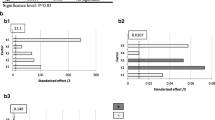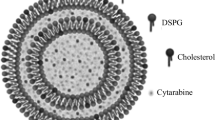Abstract
Many hydrophobic drugs have limited or no activity in clinical application due to their poor aqueous solubility. In order to find fine delivery system, we designed a novel peptide REIP (Ac-RIEIRIEIAPAIEIRIEIR) and investigated its properties as a delivery system. Microcrystal of pyrene could be stabilized by the peptide REIP and suspended in aqueous solution. We used pyrene as a model hydrophobic drug and egg phosphatidylcholine (EPC) vesicles as model membranes to study the ability of REIP in hydrophobic drug encapsulation and transfer to EPC vesicles (liposome) by analyzing the fluorescence spectroscopy of pyrene. It was found that pyrene was present in the crystalline form when stabilized by REIP and was able to transfer into EPC vesicles in molecular form. The concentration of pyrene released into the EPC vesicles at a given time was quantified using a calibration curve. Double exponential curve fitting was better for the release profiles of REIP-Py solution than single exponential curve fitting.





Similar content being viewed by others
References
Akiyoshi K, Kobayashi S, Shichibe S et al (1998) Self-assembled hydrogel nanoparticle of cholesterol-bearing pullulan as a carrier of protein drugs: complexation and stabilization of insulin. J Control Release 54(3):313–320
Chen P (2005) Self-assembly of ionic-complementary peptides: a physicochemical viewpoint. Colloids Surf A Physicochem Eng Aspects 261(1–3):3–24
Discher DE, Eisenberg A (2002) Polymer vesicles. Science 297(5583):967–973
Dong DC, Winnik MA (1984) The Py scale of solvent polarities. Can J Chem 62(11):2560–2565
Ellis-Behnke RG, Liang Y-X, You S-W et al (2006) Nano neuro knitting: peptide nanofiber scaffold for brain repair and axon regeneration with functional return of vision. Proc Natl Acad Sci USA 103(13):5054–5059
Fung SY, Yang H, Chen P (2007) Formation of colloidal suspension of hydrophobic compounds with an amphiphilic self-assembling peptide. Colloids Surf B Biointerfaces 55(2):200–211
Gao C, Qian H, Wang S, Yan D, Chen W, Yu G (2003) Self-association of hyperbranched poly(sulfone-amine) in water: studies with pyrene-fluorescence probe and fluorescence label. Polymer 44(5):1547–1552
Kalyanasundaram K, Thomas JK (1977) Environmental effects on vibronic band intensities in pyrene monomer fluorescence and their application in studies of micellar systems. J Am Chem Soc 99(7):2039–2044
Kang BK, Chon SK, Kim SH et al (2004) Controlled release of paclitaxel from microemulsion containing PLGA and evaluation of anti-tumor activity in vitro and in vivo. Int J Pharm 286(1–2):147–156
Keyes-Baig C, Duhamel J, Fung SY, Bezaire J, Chen P (2004) Self-assembling peptide as a potential carrier of hydrophobic compounds. J Am Chem Soc 126(24):7522–7532
Li F, Wang J, Tang F et al (2009) Fluorescence studies on a designed self-assembling peptide of RAD16-II as a potential carrier for hydrophobic drug. J Nanosci Nanotechnol 9(2):1611–1614
Lin J, Zhou Q, Zhao X (2009) Study on the designed self-assembling peptide as potential drug carrier by fluorescence spectra. Spectrosc Spectral Anal 29(10):2792–2797
Meng H, Chen L, Ye Z, Wang S, Zhao X (2009) The effect of a self-assembling peptide nanofiber scaffold (peptide) when used as a wound dressing for the treatment of deep second degree burns in rats. J Biomed Mater Res B Appl Biomater 89B(2):379–391
Papahadjopoulos D, Allen TM, Gabizon A et al (1991) Sterically stabilized liposomes: improvements in pharmacokinetics and antitumor therapeutic efficacy. Proc Natl Acad Sci USA 88(24):11460–11464
Rangel-Yagui CO, Pessoa-Jr A, Tavares LC (2005) Micellar solubilization of drugs. J Pharm Pharm Sci 8(2):147–163
Ruan L, Zhang H, Luo H et al (2009) Designed amphiphilic peptide forms stable nanoweb, slowly releases encapsulated hydrophobic drug, and accelerates animal hemostasis. Proc Natl Acad Sci USA 106(13):5105–5110
Sapra P, Allen TM (2003) Ligand-targeted liposomal anticancer drugs. Prog Lipid Res 42(5):439–462
Stepanek M, Krijtova K, Prochcizka K, Teng Y, Webber SE, Munk P (1998) Solubilization and release of hydrophobic compounds from block copolymer micelles I. Partitioning of pyrene between polyelectrolyte micelles and the aqueous phase. Acta Polym 49(2–3):96–102
Xu Z, Gu W, Huang J et al (2005) In vitro and in vivo evaluation of actively targetable nanoparticles for paclitaxel delivery. Int J Pharm 288(2):361–368
Yekta A, Xu B, Duhamel J, Adiwidjaja H, Winnik MA (1995) Fluorescence studies of associating polymers in water: determination of the chain end aggregation number and a model for the association process. Macromolecules 28(4):956–966
Zhang S, Gelain F, Zhao X (2005) Designer self-assembling peptide nanofiber scaffolds for 3D tissue cell cultures. Semin Cancer Biol 15(5):413–420
Zhao X, Nagai Y, Reeves PJ, Kiley P, Khorana HG, Zhang S (2006) Designer short peptide surfactants stabilize G protein-coupled receptor bovine rhodopsin. Proc Natl Acad Sci USA 103(47):17707–17712
Acknowledgments
This work was financially supported in part by National Natural Science Foundation of China (NSFC) grant 31070889 and also by the National “985 Project” of the Ministry of Education of China to Sichuan University.
Author information
Authors and Affiliations
Corresponding author
Rights and permissions
About this article
Cite this article
Lu, Y., Zhao, X. Fluorescence Studies on a Designed Peptide of REIP as a Potential Hydrophobic Drug Carrier. Int J Pept Res Ther 17, 81–86 (2011). https://doi.org/10.1007/s10989-011-9245-0
Accepted:
Published:
Issue Date:
DOI: https://doi.org/10.1007/s10989-011-9245-0




